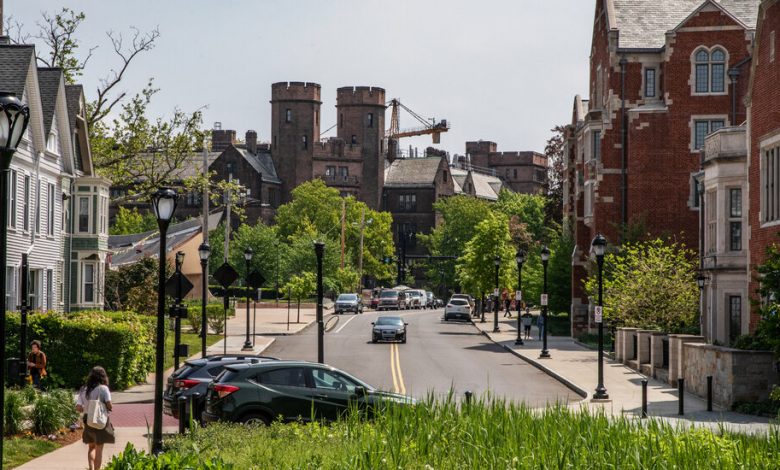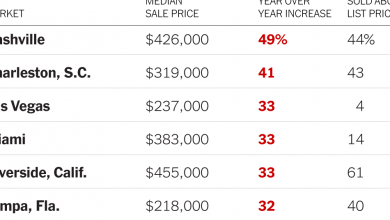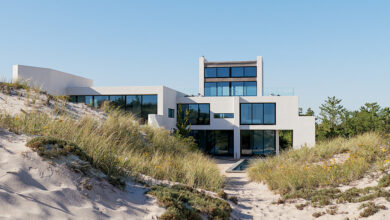New Haven, Conn.: More Than Just Academics and Mozzarella

Outsiders often reduce New Haven to two things: pizza and Yale.
It’s somewhat true. Places to eat pizza abound in this midsize city of 135,000 residents, which continues to have a large Italian-American population, even as it diversifies. And the Ivy League university, whose students and staff number about 32,500, exerts an influence that can seem far more gravitational than the school’s real estate footprint — just 8 percent of the city’s land — might suggest.
But that misses the big picture, the city’s boosters say. New Haven pulls off a balancing act, offering the cuisine, culture and architecture of a major metropolis, they contend, with the laid-back vibe of a smaller town. At the same time, decades of efforts to curb crime, clean sidewalks, convert closed factories and boost homeownership amid a 25 percent poverty rate seem to have given New Haven a new lease on life.
“I had a lot of negative feelings about the way it was in the ’80s and ’90s,” said Jim Kenny, 43, who grew up in rural Connecticut and would race through New Haven to catch the train to New York.
But in 2018, Mr. Kenny, who works in scholastic fund-raising, had to reconsider his opinion after accepting a job offer from Yale. Although he was initially tempted by suburban Milford, he took a leap of faith on a two-bedroom, one-bath apartment in a walk-up building in Wooster Square, a rowhouse-lined historic district, for $1,750 a month.
Almost immediately, he was surprised by how wrong he had been about the city. “My decision to live here unlocked a gem of a place,” said Mr. Kenny, whose unexpected treats included plays at Long Wharf Theater and Indian food at Sherkaan. This winter, he and Odie, his French bulldog, moved into a new rental building around the corner, with amenities like a fireplace-lined courtyard; his one-bedroom there costs $2,100 a month.
Large rental developments — which have been mushrooming in recent years in neighborhoods like Wooster Square, East Rock and the Hill — seem to fill up as quickly as they open, although they aren’t universally loved. In a city of Victorians and brick rowhouses, some of the projects are considered too large. But their defenders point out that new buildings are replacing parking lots, helping to reverse the city’s troubled legacy of demolitions in the mid-20th-century.
“I don’t think people are jumping up and down for joy, but I do think some of these buildings are better than having ugly empty lots,” said Charlotte Murphy, 78, a retired communications professional who lives in a two-bedroom, two-bath condominium in a converted 1865 mansion with her husband, Charlie Murphy, 80, a retired librarian. The unit, which has a fireplace, cost $189,000 in 2003, when Ms. Murphy left the suburbs for a place with walkability. “I think a lot of us are ambivalent.”
New Haven’s upswing is not citywide. Blighted blocks endure in neighborhoods like Dixwell and Dwight. But some of the city’s less affluent areas are also improving.
“It’s better here, by buckets,” said Monika Mittelholzer, 61, a seven-year resident of Newhallville, a working-class enclave. One reason is that renters, including low-income ones, are taking advantage of programs designed to help them buy, said Ms. Mittelholzer, an immigrant from Guyana who works as an administrative assistant at Yale’s medical school and lives with her sister, Sonja, 54.
Home for her is a three-bedroom, two-and-a-half-bath house that she bought for $140,000 in 2015 from Neighborhood Housing Services of New Haven, a nonprofit that rehabs and sells distressed properties at low prices to buyers with qualifying incomes. The group, which has turned around some 300 houses since 1979, can seem to be reshaping whole blocks. It restored eight houses on Ms. Mittelholzer’s section of Lilac Street alone.
But Yale also helped Ms. Mittelholzer with her down payment and mortgage through its Homebuyer Program, which typically offers employees $30,000 to buy in struggling areas. Since 1994, 1,370 properties have benefited, said Karen Peart, a Yale spokeswoman.
In 2002, when Ms. Mittelholzer moved to the area, “I thought New Haven was depressed,” she said. “But it’s coming up.”
What You’ll Find
Hugging a harbor between a pair of stone ridges known as East and West Rocks, New Haven is mostly flat, which explains its popularity with walkers and cyclists, residents say.
Many buyers start hunting in East Rock, where colorful houses in late-19th-century Queen Anne and Mediterranean styles relax in shaded yards. Mansion-lined Saint Ronan and Livingston Streets are among the top addresses, but elegant porch-fronted two-family houses, whose mortgages are offset by rents from Yale students, are abundant off Orange Street, a cafe-dotted strip.
With inventory low, there has been renewed attention on Westville, whose retail hub, at Whalley Avenue and Fountain Street, next to Edgewood Park, offers Camacho Garage, an outdoor restaurant. Farther out is East Shore, which mixes beachy and suburban vibes, with colonials on small lots by a sea wall. Neighborhoods now popular with investors include Fair Haven, a one-time oystering area on the Quinnipiac River.
Over the past 30 years, as office buildings near the New Haven Green have shed tenants, developers have grabbed the sites for housing. The Center Court Apartments, at 116 Court Street, for example, are now condos. But downtown is mostly rentals, a trend ignited by the 2010 construction of 360 State Street, a 32-story, 500-unit tower that is among the tallest in the city.
Corsair, a 238-unit project with a pool in its courtyard, occupies a spot where airplane propellers were once manufactured; a second, 75-unit complex will rise across the street. A sprawling former Winchester gun plant, targeted for redevelopment for decades, has added 158 apartments and was approved this spring for 287 more, which will join biotech offices. And Audubon Square, a phased project adding 464 rentals to several large parking lots, is being built by Spinnaker Real Estate Partners, which is also helming the 500-apartment redevelopment of the windswept site where the New Haven Coliseum once stood, with plans to break ground this year.
What You’ll Pay
Inventory is scarce. In late May, buyers could choose among 86 homes, according to Zillow. The priciest was a stone-detailed house with seven bedrooms and seven fireplaces in the 185-acre Prospect Hill Historic District, built in 1908 for the owner of a trolley company, and listed for $2.295 million. The least expensive was a Cape Cod-style fixer-upper on 0.12 acres in East Shore, listed for $119,000. There were also 19 condominium units for sale, from $39,900 to $470,000.
As inventory has tightened, sales have slowed, sending prices skyward. New Haven saw 61 single-family houses sell in the first quarter of 2022, according to data from William Pitt Sotheby’s International Realty, down from 71 during the same quarter in 2021. The median sale price for a single-family home in the first quarter of 2022 was $278,000, up from $231,000 during the same period the year before, a 20 percent jump.
Multifamily homes — a big part of the city’s housing stock — also saw values soar. Two- to four-family houses had a first-quarter median sale price of $325,000, up from $285,000 a year ago, according to Sotheby’s data. The median sale price of condos increased as well, to $158,000 in the first quarter of 2022 from $135,000 a year ago.
Jack Hill, an agent with Seabury Hill Realtors, who sold about 100 properties in New Haven last year, said the market is resetting. “I think it’s poised to come down a little bit,” he said. “Though not anything unusual.”
The Vibe
For years, relations between Yale and New Haven were chilly, largely because the private university kept taking buildings off tax rolls by snapping them up. But a thaw began around 1990, city officials say, as Yale began making voluntary payments to offset those losses. Last year, the school agreed to pay $135 million over six years, a large increase over past rates.
Many residents admit that Yale brings a flood of culture that a former factory town might not enjoy otherwise. Highlights include two world-class art museums; a natural-history museum, the Peabody, which is beloved by children; and Woolsey Hall, a venue for classical music. In recent years, improvements to Yale-owned properties along Broadway have turned a strip once rowdy with nightclubs and diners into a more upscale shopping destination.
Elsewhere, College Street Music Hall holds rock, funk and pop shows; across the street, the Shubert Theater is a destination for ballets and musicals. And while many of the city’s green spaces are variations on the quad or the square, looping paths along Mill River, at the base of East Rock, offer space to jog and walk.
The Schools
New Haven’s 41 public schools — 32 of them magnet schools — enroll about 19,500 students.
On 2019 Smarter Balanced assessment exams, given in third through eighth grades, 55 percent of students met standards in English, compared with 60 percent statewide; 54 percent met standards in math, versus 63 percent statewide.
The high schools’ four-year graduation rate last year was 79 percent, versus 90 percent statewide, according to a state report that also found that New Haven spends slightly less per student — $16,929 annually — than the $17,838 state average.
The Commute
Metro-North’s New Haven line has two stops in New Haven and offers eight trains from Union Station to Grand Central on weekdays between 6 a.m. and 8 a.m. The shortest takes an hour and 50 minutes; the longest is just over two hours. Monthly passes are $450.
Amtrak and local Shore Line East trains also serve Union Station. New York-bound trains run a few times a day from New Haven’s other station, on State Street, closer to downtown.
Bus service is provided by CT Transit and Yale to those who commute within the city. Commuters can also opt to pedal their way around, courtesy of Bike New Haven, a four-year-old bike-sharing program.
The History
From 1701 to 1875, Connecticut enjoyed the unusual distinction of having two state capitals, Hartford and New Haven. The capitol in New Haven — a Greek temple-type structure on the upper green, between Center Church and Phelps Gate, the entrance to the oldest surviving part of Yale’s campus — was designed by Ithiel Town, the architect behind the similar-looking Federal Hall National Memorial, on Wall Street in Manhattan.
The power-sharing arrangement, which had lawmakers meeting in each city once a year, eventually became too costly, and in 1885, after Hartford became the sole capital, Mr. Town’s temple was razed. The marble remains ended up in basement walls around the city, while its mortar was used to fill potholes, according to the New Haven Museum.
For weekly email updates on residential real estate news, sign up here. Follow us on Twitter: @nytrealestate.
Source link






